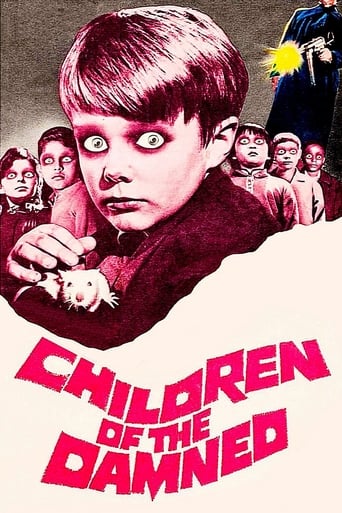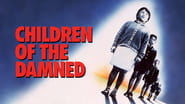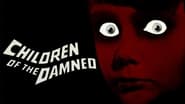ferbs54
In the 1960 sci-fi/horror thriller "Village of the Damned," five small communities around the world had been put to sleep by a mysterious agency and all their women capable of childbirth immaculately made preggers. The resultant children had evinced powers of mental control, a hyperaccelerated physical development and a hive mind; by the end of the film, all the children had been slain by their panicky respective nations. Thus, a follow-up to this classic film would seemingly have been an unlikely prospect. And yet, four years later, that sequel, "Children of the Damned," made its unexpected appearance. Released in January 1964 and sporting the alarming advice to "Beware the Eyes That Paralyze!" on its promotional poster, the film turned out to be a remarkably satisfying sequel, featuring all-new characters, a completely different story line, and a wholly different feel, as compared to the first picture. Another product of MGM's British branch, and again sporting an intelligent and adult script, first-rate acting and gorgeous B&W cinematography, "Children" can proudly hold its head high next to its famous forebear.In the film, UNESCO has, for the first time, given a standardized IQ test to kids all around the world, and with startling results. Six children--four boys (from the U.K., Nigeria, India and the U.S.) and two girls (from Russian and China)--have turned in tests that indicate identical, impossibly high IQ scores. The six are brought together in London for study, and psychologist Tom Lewellin (the great British actor Ian Hendry) and geneticist David Neville (Alan Badel) begin their examination. But the children--who also demonstrate the same psi powers, hive mind, freakishly glowing eyes, and powers of mental coercion as the kids in the first film--soon band together, kidnap the Brit kid Paul's pretty Aunt Susan (Barbara Ferris), and hole up in an abandoned church, while the heads of their respective governments ponder how to get them back or, possibly, destroy them. It would seem that a murderous showdown between the freakishly gifted kids and the panicky world leaders might be inevitable again....There are several salient differences between "VOTD" and "COTD," despite their surface similarities. Of basic importance is the fact that the kids in the first film are suggested to be alien in nature, and with their uniform blonde looks, they certainly do appear otherworldly and unsettling. The children in the sequel, on the other hand, are supposed to be biological sports who have miraculously arisen simultaneously. The kids in the first film are not sympathetic in nature; those in the second most definitely are, especially with their differentiated cute looks (the little Chinese girl is adorable) and after the audience learns that the kids are wholly human, just evolved to a point perhaps a million years in mankind's future. There is more agonized soul searching as to what to do with these problematic children in the second film, with Hendry very much our moral compass, and while both films end on a decided down note, the events of the latter picture seem even more tragic, due to the sympathetic nature of the kids here. "COTD," as screenwriter John Briley tells us during the DVD's commentary, is more of a "moral fable of the Cold War," whereas the first had been most clearly a science-fiction scarifier. And if possible, the six kids of the sequel cause even more of a worldwide tizzy than the 12 alien kids of the British village of Midwich in the original outing!As to the similarities, both films boast absolutely first-rate, moody B&W lensing (by cinematographer Geoffrey Faithful in the first film and David Boulton in the second) and taut direction (Wolf Rilla in the former; Anton M. Leader, who otherwise worked almost exclusively for television, in the latter). As in the initial outing, the most memorable scenes in "COTD" for the viewer will most likely be the ones in which the kids use their powers to punish perceived threats on the part of their elders. Hence, in the sequel, Paul attempts to kill his mother by forcing her to walk in traffic; one government agent is coerced to shoot another and then to walk off a high balcony in that abandoned church; the children use some kind of sonic device to stop the attack of foreign kidnappers; and three British officials are compelled to slay one another by stabbing and strangulation. Two other similarities that the films share: crackerjack, literate scripts and remarkably fine acting down to the smallest bit players. Very much a class act all the way, this is one sequel that really does live up to its original, complementing the first while piling on new layers of meaning and additional food for thought. An "all-new suspense shocker," that promotional poster proclaimed, and for once, the advertising hyperbole turns out to be precisely true! This is superior, adult entertainment all the way!
gizmomogwai
A sequel to the creepy Village of the Damned (1960), Children of the Damned fumbles some key points and what works is just rehashed from the original. Of course, George Sanders is not back. The eerie children are back, this time from several different countries, but they're missing the trademark light hair. The sequel tries to provide more of an explanation of what the children are- not alien hybrids, it turns out, but humans from a million years in the future. That was something I didn't really want to hear- it contradicts the original, which kept the children's origins unknown but with strong hints of extraterrestrial influence.Minus the more conclusive explanation of the children, this movie is not all that different from the original. Once again, we have the children killing would-be attackers with their mind powers; once again, we have the humans debating whether the children should be killed, with one suggesting they can be of use to the human race and should be spared. In the end, troops seem to explode the church the children are staying at- but the original had established troops are no threat to these children. The children in this movie seem to want to be destroyed, but why? Because the makers of the film couldn't think of another way to end it? In the end, this movie is unsatisfying and pointless.
Matthew Kresal
When a film is a success, it is almost inevitable there will be a sequel to it. The classic 1960 sci-fi film Village Of The Damned is no exception to that rule and 1964's Children Of the Damned would be that sequel. While any sequel to Village Of The Damned would have big shoes to feel, this film doesn't quite live to the standards set by the original film. In fact, it is easy to say that Children Of The Damned is very much a sequel in name only that, contradictorily, requires knowledge of the original film for it to make sense as well as being a terribly dated Cold War parable.The film certainly has a respectable cast. Ian Hendry and Alan Badel play Tom Llewellyn and David Neville, who both give believable performances as the two scientists who uncover the children and their powers. Barbara Ferris plays the aunt of one of the children who ends up becoming a spokesperson for the children while under their control. Alfred Burke gives perhaps the film's best performance as British government agent Colin Webster whose involvement only makes the situation worse as the film goes on. Together they are a cast that is more then a match for that in the original film.One of the film's problems though is in its title characters: the children. Due to whatever reason, gone are the seemingly normal yet otherworldly and menacing children of the original. These children are the exact opposite. They are utterly normal children from five places around the world who lack any of the otherworldly feeling or menace of the original children. Even the special effect used on the eyes when the children are using their powers isn't really used and, when it is, it just doesn't look stand up to the effect used in the original film. The result is that perhaps one, single essential element of the film that needed to work just doesn't work.The production values of the film are excellent. In particular the stark black and white cinematography of Davis Boulton gives the film a strong sense of atmosphere and menace throughout which helps the film immensely. The production design of Elliot Scott give the film the same feeling as the cinematography, especially in the form of the destitute church the children come to occupy for much of the film. One element that improves in this film is the score by composer Ron Goodwin that, after a rather mixed result in the original film, is never out of place and put to good use throughout. The success of the production values helps the film out immensely.Along with the children, the script is another essential element that ends up having a rather mixed result. If anything, the script presents this film as a rather confused sequel to say the least. The script seems to require that the viewer have seen the original film to understand all the events taking place. Yet the film seems to spend most of its time wanting to distance itself as far as possible from the original film. The result is a confusing mix: the plot and events make little sense without having seen the original film but the story might as well be anything but a sequel. It also doesn't help that the film, by the admission of screenwriter John Briley, was more or less meant to be more of a Cold War parable. The children can be viewed as scientists around the world who the major Cold War powers (represented by the government officials in the film) want to put to use building ever more powerful weapons of mass destruction. While this would be a good idea to have explored somewhere else, this film doesn't really seem to be either the place to do it or even do it well. If anything the script seems to be drowning in good ideas (such as the revelations that come out in the films last few minutes) that are never put to good use. Also the Cold War parable gives this film something the original doesn't have: a terribly dated feel to it. The result is that the script is a rather mixed affair.Children Of The Damned, even when viewed on its own and not as a sequel, is a rather mixed affair. Despite a fine main cast and excellent production values, the film's supporting cast (the children) and its script both are rather mixed in their results. When viewed as a sequel however, the film comes across as a rather confused sequel that requires knowledge of the original film for it to make sense as well as being a terribly dated Cold War parable to the point of becoming a sequel in name only. All this means that, while a decent film, it never quite works either as a sequel or as an original film either and is a bit of a letdown overall.
ShadeGrenade
'Village Of The Damned' ( 1960 ) ended with the Midwich children blown sky-high by a bomb in a briefcase. Four years later, 'Children Of The Damned' appeared. As John Wyndham had never written a follow-up novel, it was left to John Briley ( later to write 'Gandhi' ) to concoct an original work. Psychologists Colonel Tom Llewelyn ( Ian Hendry ) and Dr.David Neville ( Alan Badel ) are investigating the backgrounds of a group of children from different countries, all of whom possess incredibly high levels of intelligence. The mother ( Sheila Allen ) of one tells them she was a virgin when her son came into the world. When she bawls him out, he forces her to walk into the path of a lorry.The children escape from custody, taking refuge in a derelict church in London. Attempts to force them out meet with little success - the children use their powers on the adults each time. Finally, the army is brought in...Not as good as 'Village' but nevertheless a solid British sci-fi film. Strangely, the first film's events are not mentioned. The Midwich children had blonde hair, these are dark. Their eyes still turn white whenever they use their powers though. The Midwich kids were believed to be aliens - no-one in 'Children' considers this possibility. Instead they are said to be the next stage in human evolution. Not evil as such, they only kill when threatened. Exactly what they are doing on Earth is never revealed. Asked to explain themselves, one says enigmatically: "To be destroyed!". How did they manage to build a solar-powered machine that kills by amplifying the sound of the church organ? A difference of opinion arises between the Hendry and Badel characters. Llewelyn thinks the children should be allowed to live, Neville believes they pose a threat to Mankind and need to be destroyed. Once again Ron Goodwin's music is wonderful ( particularly effective is his use of an electric organ whenever the children use their powers ). The director, Anton M.Leader, later worked on American shows such as 'Get Smart!' and 'Lost In Space'. He does a good job overall, building suspense to a shattering climax as the army accidentally destroy the church ( and killing the kids in the process ). No further films in the series appeared. Some mistakenly regard Joseph Losey's 'These Are The Damned'( 1963 ) as part of it, but apart from the idea of deadly children ( radioactive, not super-intelligent ) they have nothing in common.








